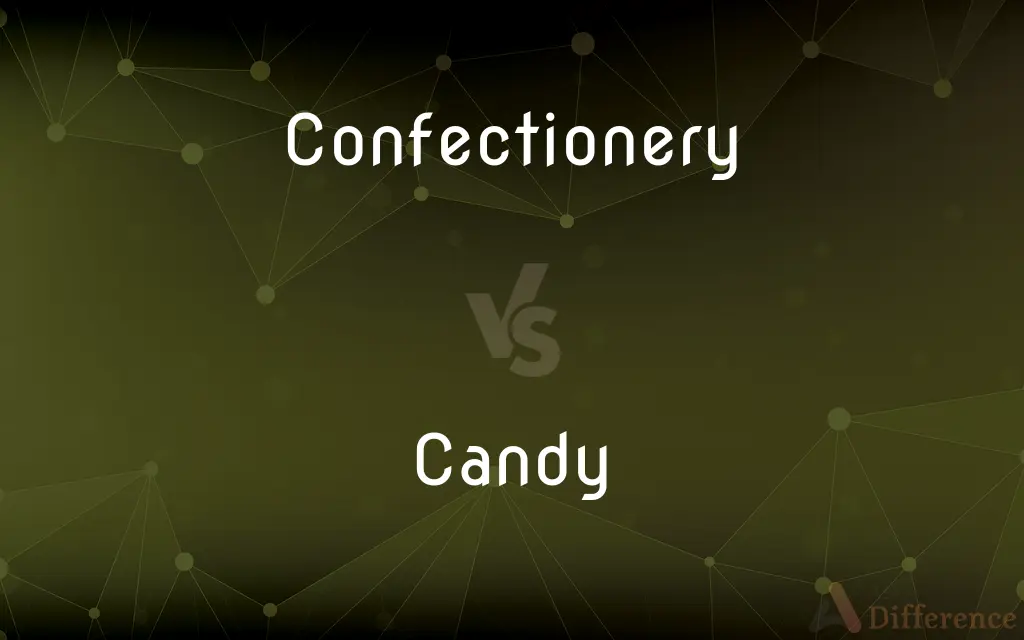Confectionery vs. Candy — What's the Difference?
By Maham Liaqat & Urooj Arif — Updated on March 19, 2024
Confectionery encompasses a wide range of sweet treats, including candies, whereas candy is specifically sugar-based sweets popular in varieties like chocolates, gummies, and hard candies.

Difference Between Confectionery and Candy
Table of Contents
ADVERTISEMENT
Key Differences
Confectionery is a broad term that refers to various sweet foods and treats, including chocolates, cakes, pastries, and candies. It is known for its wide variety in terms of ingredients, textures, and flavors, catering to different tastes and occasions. On the other hand, candy specifically denotes a subset of confectionery that is primarily made from sugar and often includes ingredients like chocolate, fruits, nuts, and flavorings to create different types. Candy is characterized by its sugar concentration and is typically enjoyed as a quick, sweet snack.
While confectionery can be considered an art and science, involving intricate designs and flavors in items like pastries and gourmet chocolates, candy is often seen as a more straightforward pleasure. Candies are usually mass-produced and designed for long shelf life and convenience, contrasting with the sometimes delicate and perishable nature of other confectioneries.
Confectionery often has cultural and traditional significance, with specific sweets associated with holidays, celebrations, and rituals around the world. Candy, while also enjoyed during celebrations, is more universally recognized as a casual treat, less tied to specific traditions and more to general consumption.
In terms of health and nutrition, both confectionery and candy are high in sugar and calories, but confectionery might offer a slightly broader range of nutritional values due to its diversity. Candies, with their high sugar content, are typically considered less nutritious and are advised to be consumed in moderation.
The production of confectionery can involve complex processes and craftsmanship, especially for items like fine chocolates and elaborately decorated cakes. Candy production, while still requiring expertise, often leans towards large-scale, automated processes aimed at producing uniform and widely appealing products.
ADVERTISEMENT
Comparison Chart
Definition
Broad category of sweet foods, including candies.
Sugar-based sweets, part of the confectionery category.
Ingredients
Can include sugar, flour, butter, chocolate, and fruits.
Primarily sugar, often with flavorings or chocolate.
Variety
Includes chocolates, pastries, cakes, and candies.
Focuses on sweets like gummies, hard candies, and chocolate bars.
Cultural Significance
Often associated with celebrations and traditions.
Seen as a casual treat with less cultural specificity.
Production Complexity
Ranges from artisanal to industrial.
Generally mass-produced with a focus on consistency.
Compare with Definitions
Confectionery
A category of sweet treats that includes a variety of desserts and candies.
The bakery's confectionery section featured everything from chocolate truffles to gummy bears.
Candy
Items that are easily portable and have a long shelf life.
Candy is popular for road trips due to its convenience.
Confectionery
Items intended for consumption during celebrations or as dessert.
Their confectionery display during the holiday season is always impressive.
Candy
Often mass-produced, focusing on uniformity and wide appeal.
The candy factory produced thousands of chocolate bars each day.
Confectionery
Products that may require intricate preparation methods.
The chef specialized in confectionery, crafting exquisite chocolate sculptures.
Candy
Products typically made with sugar, syrup, and flavoring.
The candy store offered a wide variety of flavors, from mint to tropical fruit.
Confectionery
Sweet food items made primarily from sugar and often decorated or flavored.
For the wedding, they ordered an assortment of confectionery from around the world.
Candy
Sweet, sugary treats often eaten as a snack or quick dessert.
She always kept a jar of candy on her desk for a midday treat.
Confectionery
A term encompassing both mass-produced and artisanal sweet foods.
The confectionery industry has seen growth in both traditional and innovative products.
Candy
Can be categorized into types such as hard, soft, gummies, and chocolates.
His favorite type of candy was hard candy, especially lemon drops.
Confectionery
Confectionery is the art of making confections, which are food items that are rich in sugar and carbohydrates. Exact definitions are difficult.
Candy
Candy, also called sweets (British English) or lollies (Australian English, New Zealand English), is a confection that features sugar as a principal ingredient. The category, called sugar confectionery, encompasses any sweet confection, including chocolate, chewing gum, and sugar candy.
Confectionery
Sweets and chocolates considered collectively
A confectionery company offering hand-made chocolates
Items of confectionery
Candy
A rich sweet confection made with sugar and often flavored or combined with fruits or nuts.
Confectionery
Candies and other confections considered as a group.
Candy
A piece of such a confection.
Confectionery
The skill or occupation of a confectioner.
Candy
(Slang) An illicit drug, especially one, such as cocaine, that has a sugary appearance or a drug in pill form, such as MDMA.
Confectionery
A confectioner's shop.
Candy
To cook, preserve, saturate, or coat with sugar or syrup
Candy apples.
Candy ginger.
Confectionery
(uncountable) Foodstuffs that taste very sweet, taken as a group; candies, sweetmeats and confections collectively.
Candy
Edible, sweet-tasting confectionery containing sugar, or sometimes artificial sweeteners, and often flavored with fruit, chocolate, nuts, herbs and spices, or artificial flavors.
Confectionery
(uncountable) The business or occupation of manufacturing confectionery; the skill or work of a confectioner.
Candy
A piece of confectionery of this kind.
Confectionery
A store where confectionery is sold; a confectioner's shop.
Candy
Crack cocaine.
Confectionery
Sweetmeats, in general; things prepared and sold by a confectioner; confections; candies.
Candy
(uncountable) An accessory (bracelet, etc.) made from pony beads, associated with the rave scene.
Candy kid; candy raver
Confectionery
A place where candies, sweetmeats, and similar things are made or sold.
Candy
(obsolete) A unit of mass used in southern India, equal to twenty maunds, roughly equal to 500 pounds avoirdupois but varying locally.
Confectionery
A food rich in sugar
Candy
(cooking) To cook in, or coat with, sugar syrup.
Confectionery
A confectioner's shop
Candy
(intransitive) To have sugar crystals form in or on.
Fruits preserved in sugar candy after a time.
Candy
(intransitive) To be formed into candy; to solidify in a candylike form or mass.
Candy
To conserve or boil in sugar; as, to candy fruits; to candy ginger.
Candy
To make sugar crystals of or in; to form into a mass resembling candy; as, to candy sirup.
Candy
To incrust with sugar or with candy, or with that which resembles sugar or candy.
Those frosts that winter bringsWhich candy every green.
Candy
To have sugar crystals form in or on; as, fruits preserved in sugar candy after a time.
Candy
To be formed into candy; to solidify in a candylike form or mass.
Candy
Any sweet, more or less solid article of confectionery, especially those prepared in small bite-sized pieces or small bars, having a wide variety of shapes, consistencies, and flavors, and manufactured in a variety of ways. It is often flavored or colored, or covered with chocolate, and sometimes contains fruit, nuts, etc.; it is often made by boiling sugar or molasses to the desired consistency, and than crystallizing, molding, or working in the required shape. Other types may consist primarily of chocolate or a sweetened gelatin. The term may be applied to a single piece of such confection or to the substance of which it is composed.
Candy
Cocaine.
Candy
A weight, at Madras 500 pounds, at Bombay 560 pounds.
Candy
A rich sweet made of flavored sugar and often combined with fruit or nuts
Candy
Coat with something sweet, such as a hard sugar glaze
Common Curiosities
What is confectionery?
Confectionery refers to a broad category of sweet treats, including candies, chocolates, cakes, and pastries.
Are confectioneries bad for health?
While confectioneries can be enjoyed as part of a balanced diet, their high sugar and calorie content means they should be consumed in moderation.
How are confectioneries used in celebrations?
Confectioneries are often featured in celebrations and holidays, serving as treats or gifts, and vary widely across different cultures.
How does candy differ from other confectioneries?
Candy specifically focuses on sugar-based treats, whereas other confectioneries might include baked goods or chocolate items with a wider range of ingredients.
What defines candy?
Candy is a type of confectionery primarily made from sugar, often flavored or combined with other ingredients like nuts, chocolate, or fruit.
Do confectioneries have nutritional value?
Some confectioneries, especially those with nuts, fruits, or dark chocolate, can offer nutritional benefits, but they are generally consumed for pleasure rather than health.
Can confectionery be a gift?
Yes, confectionery is a popular gift choice for many occasions, symbolizing thoughtfulness and celebration.
Can chocolate be considered candy?
Yes, chocolate can be considered a type of candy, especially when it is used as the main ingredient in bars or pieces.
Why is candy popular among all age groups?
Candy is popular due to its sweet taste, variety, and the pleasure associated with its consumption, appealing to people of all ages.
What are some popular types of candy?
Popular types include chocolate bars, gummy candies, hard candies, and chewy sweets.
Is candy a global phenomenon?
Yes, candy is enjoyed worldwide, though the types and preferences can vary by culture.
What's the difference between artisanal and mass-produced confectionery?
Artisanal confectionery is often handcrafted with attention to detail and unique flavors, while mass-produced items focus on consistency and wide availability.
What is the shelf life of candy?
Candy generally has a long shelf life due to its high sugar content, which acts as a preservative.
How is confectionery made?
Confectionery can be made using a variety of techniques, from baking to candy making, often involving sugar, chocolate, and other sweet ingredients.
Is it possible to find sugar-free confectionery?
Yes, there are sugar-free options available for those looking to reduce sugar intake, using alternative sweeteners to achieve a similar taste.
Share Your Discovery

Previous Comparison
Petrolhead vs. Motorhead
Next Comparison
Wendigo vs. ShapeshifterAuthor Spotlight
Written by
Maham LiaqatCo-written by
Urooj ArifUrooj is a skilled content writer at Ask Difference, known for her exceptional ability to simplify complex topics into engaging and informative content. With a passion for research and a flair for clear, concise writing, she consistently delivers articles that resonate with our diverse audience.














































